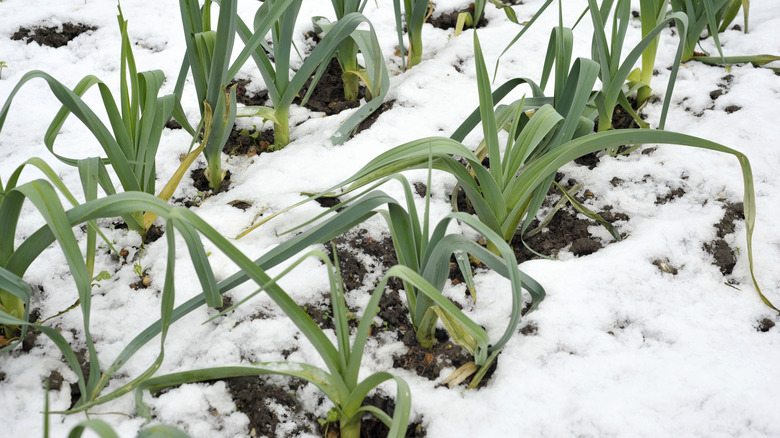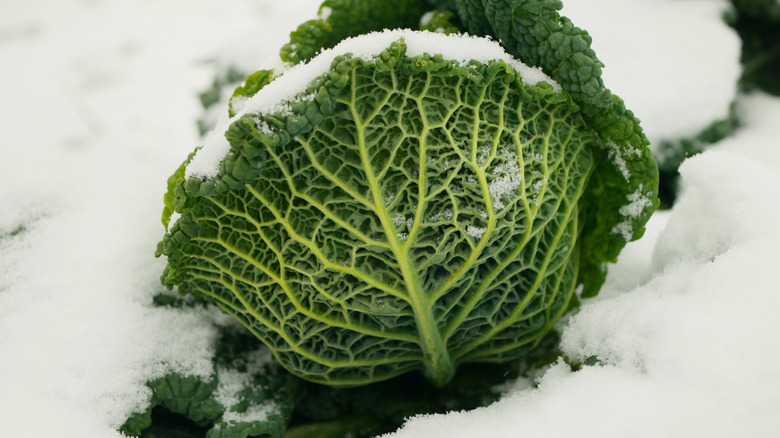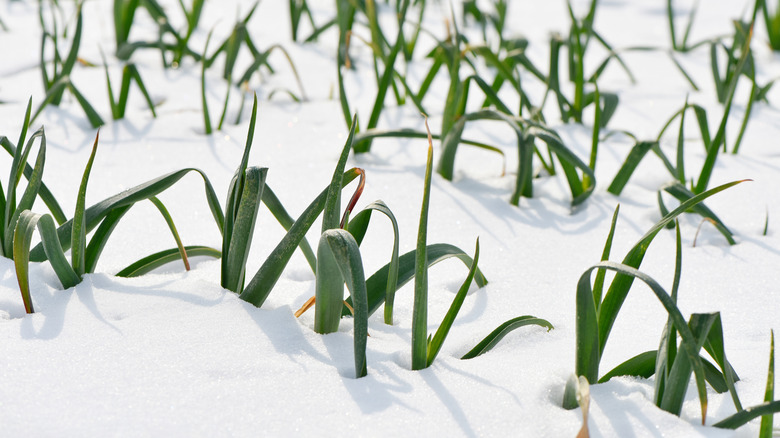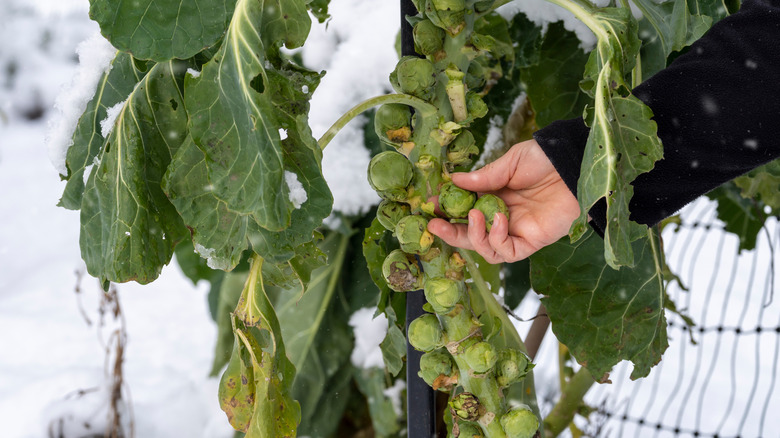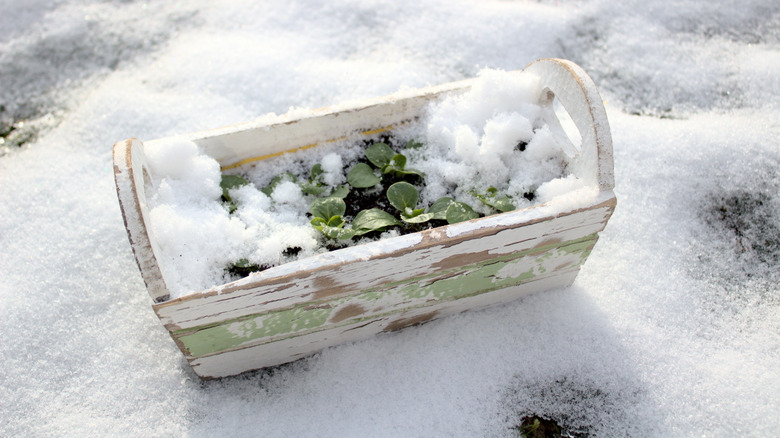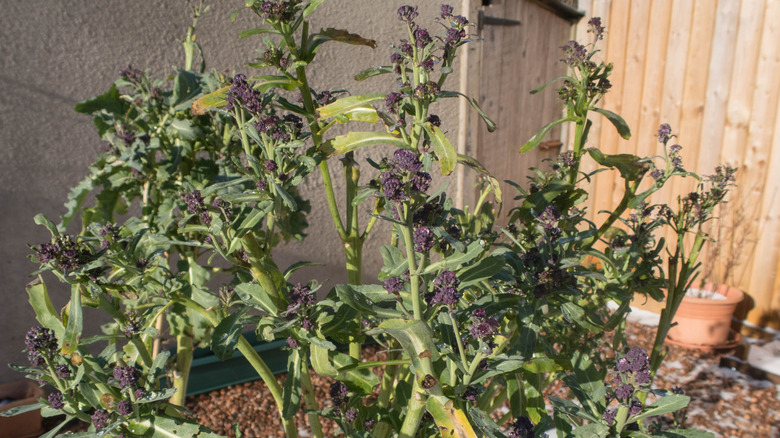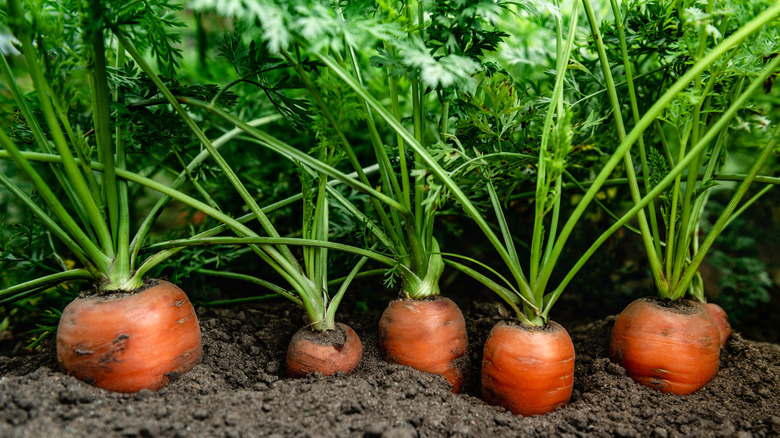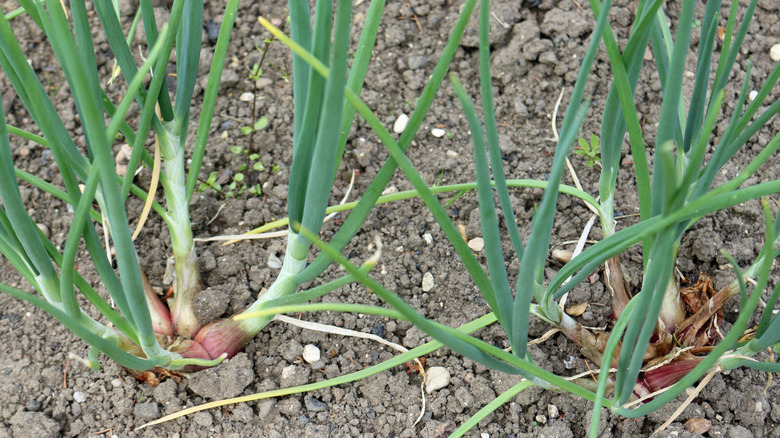13 Winter Vegetables To Grow In Your Temperate Edible Garden
We may receive a commission on purchases made from links.
Most people think that winter means everything in the garden apart from the tough old evergreens is dead or dormant. But that's not the case. Even when you grow your own food, there's plenty of crops you can still grow and harvest through the winter. Yes, tender crops are done for the season, unless you're growing them in a heated space, but a winter vegetable garden can still be a productive one.
I'm a master gardener who specializes in organic edible gardening, and I've been growing much of my own food for years. I can tell you that some of my favorite crops are what I have in the ground over winter. Brassicas, leeks, parsnips, carrots — the list goes on. I don't have fancy heated growhouses or equipment, either. Most of the vegetables that thrive over winter do need a fall (or earlier) start, but in most temperate zones, they'll survive the winter with minimal or no protection, even if you get frosts and snowfall.
Curly kale sweetens in hard frost
Winterbor kale is a curly kale that's been a staple of my vegetable garden for years. It is specifically bred for winter and can survive hard frosts and heavy snowfall with no intervention from you. There are plenty of other winter-hardy varieties too, including 'Black Magic' and cavolo nero (also known as lacinato kale), both of which I've grown with great success.
In fact, the sweetness and full flavor of winter-hardy kale improves and deepens with every frost. I love winterbor kale for its flavor, vigor, and texture. Lacinato is also among my favorites, with its dark green-to-black, fleshy leaves. Instead of pulling the whole plant, I cut only the leaves I need, when I need them, starting at the bottom of the plants and working my way upward. Taking just the outer leaves in this manner keeps the centers producing for longer. It's reasonably easy to grow, and there's only a few real mistakes you can make when growing kale.
Do note though, that if your area suddenly experiences a sustained Arctic blast, especially if the kale is in an exposed position, it's worth throwing a frost blanket over the top to keep it just a tiny bit warmer. I always keep plenty of plant covers, like the FARAER Plant Covers Freeze Protection, ready for cold snaps. Winterbor is quick to grow, too, so keep sowing at regular intervals into late September and plant out by mid-to-late fall so the seedlings have time to size up to survive deep cold. I mulch my kale rows to keep the soil a little warmer and I use fine mesh netting to keep pigeons, cabbage white, and whitefly off the plants.
Leeks with hardy shafts overwinter in the ground
Leeks generally do well over winter, with flavor improving after frosts. One of the most cold hardy varieties is 'Bandit.' This particular cultivar has large, upright blue-green leaves and sweet, firm stems that overwinter in the ground even in heavy frost and snow. You need to plant them between January and April. I usually sow direct, and wait until March or April, once the soil has warmed a bit. They mature from around January. However, I thin the row by pulling the immature leeks, which have a delicious mild flavor, to let the remaining leeks fill out as they mature.
If you live in a very cold area, you can mulch around them with straw. You can also mound soil around them, a planting trick known as blanching, while they're actively growing to encourage longer shafts. They'll form seed heads quickly in spring and become woody. If you see them start to produce a long central stem with a little bulbous lump near the top, cut those off, as they are the flower stems. If any of mine start to run to seed like that, I lift and use them right away.
Savoy cabbages have dense, full heads that hold over winter
Savoys and semi-savoy cabbages are winter-hardy vegetable garden essentials. 'January King,' as the name implies, survives the worst of the winter weather and can be harvested all throughout the coldest months. Unlike kale, you obviously harvest the whole head — but don't be afraid to take and use those big, floppy, deep green outer leaves with their beautiful pink-red veins, too. 'January King' is my go-to overwinter cabbage, as it grows big, tight heads with lovely fleshy leaves. And, like winterbor, the flavor improves after frosts.
Typically, you'd plant these indoors in trays between February and May, or outdoors direct between April and June, for a winter harvest. You can also sneak in a second sowing in late July or August for a spring harvest. These do take a long time to mature and take up quite a bit of space, as they need to be planted 2 feet apart and 2 feet between rows, but, in my opinion, they are very much worth it in terms of flavor, the size of the heads, and their reliability.
You'll definitely need to add netting to cabbages, like with most brassicas, as pigeons, deer, rabbits, caterpillars, and more will devour them if you don't. I like the GonLei Ultra Fine Garden Netting for plants like cabbages that don't need pollination. And, in extreme weather, it's a good idea to add a fleece blanket over top of the netting. They are reasonably heavy feeders, and because they take so long to mature, I like to side-dress with compost or well-rotted manure when I see the heads just starting to form. Then, once winter hits, I add a layer of straw as mulch beneath the netting, but not right up against the bases, or you create a haven for slugs that will quickly destroy your crop.
Garlic needs winter cold to thrive
Garlic is so easy to grow and stores well for many months. But it does need a bit of pre-planning. Get it in the ground in mid to late fall, as it needs at least a month of cold weather to get the cloves to turn into bulbs and actively start growing. Separate the large bulb into cloves, and plant each clove by pushing it into the soil, leaving around a half-inch exposed.
As with shallots, you might want to add netting to stop birds from pulling out the cloves before they have chance to root themselves. There are plenty of varieties to choose from, but I like 'Rose Wight' and 'Kingland Wight.' I also grow elephant garlic for its huge bulbs that can weigh over 1 pound.
Brussels sprouts are reliable and cold-hardy
Brussels sprouts are much maligned, but I adore them. Sprouts finely sliced and pan-fried with bacon is a ridiculously delicious side, especially for Thanksgiving or Christmas. And 'Long Island Improved' is one of my staple choices. They are very cold-hardy and can survive right through to late winter, holding, but not growing, in the ground. These heirloom Brussels will give you a heavy crop of medium-sized sprouts on 24-inch central columns.
You can start to harvest from the bottom up as soon as you see the actual sprouts start to turn into firm heads. And, although most people don't know this, you can eat the leaves that grow between the actual sprout buds just like cabbage. Again, harvest those from the bottom up, too. And, if your sprouts "blow," which is where the buds don't form properly and you get loose little groups of leaves instead, still use them as leafy greens.
You can sow these indoors from January to February for a same-year harvest, and get a second sowing in for late winter/early spring harvest by starting seeds in late July to August. They take around 100 days from seed to maturity, and require plenty of sun. To encourage sprout formation, once the plant reaches its full height (between 20 and 24 inches in the case of 'Long Island Improved'), I just pinch out or cut off the growing head. This diverts the plant's energy into producing the sprout buds. To reduce the risk of the buds blowing, don't give too much nitrogen, and plant them where they're not too exposed to wind.
Corn salad rosettes can handle hard frosts
Corn salad, or lamb's lettuce, is a true winter green that produces small, nutty rosettes that give you easy to grow salad all winter long. I grow lamb's lettuce every year, as it's robust and cold hardy and, if you sow it thickly, will give you plenty of fresh salad leaves right through the cold winter months.
I sow several crops of this, starting in early fall, then adding an extra crop every other week until late fall. It's a good choice for beds that are somewhat lacking in nutrients, because it doesn't need rich or deep soil to do well. When harvesting, you can take a few leaves at a time, or just take whole rosettes at once.
Purple sprouting broccoli gives beautiful, late-winter spears
Another member of the brassica family, purple sprouting broccoli, is colorful and cold-hardy. 'Purplicious' and 'Red Fire' are both solid options. Purple sprouting broccoli bridges that hungry gap beautifully between mid-winter and mid-spring. Just be aware that, while it will last in the ground all winter, once mid-spring hits and the temperature starts to warm consistently, this broccoli will quickly begin to flower and the stems become woody and unpalatable, so make the most of it over the winter.
Start them from seed successionally from February to June, and harvest from November to the following May. They take a long time to grow, but if you harvest them correctly, they crop all through winter and into spring. And, as with other brassicas, you can and should eat the leaves. It's free food, after all. Remember to net them against browsers and insect pests. And in very cold climates, add a fleece blanket for a little extra insulation. Once it's large enough, harvest the central head, similar to regular broccoli, to encourage the plant to put its energy into producing side shoots that you can harvest through winter.
Parsnips are sweeter after multiple frosts
Parsnips are one of the many vegetables that grow underground that are easy to grow and don't like to be coddled. Many people complain about the bland taste of grocery store parsnips, and that's because most commercially-grown ones are forced and out of season — and haven't been exposed to frosts. Parsnips need repeated frosts to fully develop their true rich, sweet, earthy flavor, as the intense cold turns their starches to sugars.
One of the cultivars I recommend is 'Gladiator,' as it's disease-resistant to parsnip canker and can survive in frozen ground until the spring. It produces long, slender roots that are nutty and flavorsome. And, if you do need to lift them before spring, they store very well if you remove the tops and leave them in a cardboard box in the garage.
Carrots can grow in winter if you choose autumn-sown varieties
Most people think the last of their carrots should be pulled in late summer or early fall. But, if you choose the right variety, like 'Napoli,' or other late-sown Nantes types, they'll produce small to medium-sized carrots that will survive in the ground over winter in most climates with only a little help. Direct sow them in late summer to early fall.
You need to thin the seedlings as soon as they are big enough to handle, so the remainder can fill out before winter arrives. Even with a late planting, I'd still recommend you grow onions nearby as companion plants, and cover the carrots with fine mesh to prevent carrot root fly. Once winter really hits, you can use straw to mulch around and between carrots, making sure you leave at least half the length of the tops visible. In very cold climates, add a fleece row cover for extra warmth. You can pull the carrots through the winter and into spring. If you're worried about them — for example, if it's extremely wet and they're at risk of rotting — lift them early, cut off their tops, and store in the dark in an unheated space.
Turnips give you tender roots and greens through winter
Salad turnips are one of those vegetables that have a reputation as boring or bland. But they are delicious. I love them raw and will happily eat them like apples. Luckily, varieties like 'Hakurei' can be sown under fleece from early fall. Others you could try are 'Scarlet Queen Red Stems' and 'Purple Top White Globe.'
Thin them when the seedlings are big enough to handle to give the remainder room to fill out. Start harvesting alternate turnips once they reach golf ball size. You can use both the roots and the greens. I add the greens to salads and stir-fries. Pulling alternates lets the others fill out to tennis ball size, at which point they develop a deeper flavor and they're great to adding to stews, mashing with potatoes, carrots, or rutabagas, for a creamy, buttery mash.
Fava beans overwinter for early harvests
Fava beans help fill that hungry gap in April and June when substantial harvests are still scarce. You do need the right variety though, as some can't tolerate winter conditions. 'Aquadulce Claudia' is a great choice for most climates, although you will need row covers for them if temperatures regularly dip below 20 degrees Fahrenheit. Even when planted late, fava beans attract aphids and black flies, so once they reach their full height, nip out the growing tip to deter these pests.
I sow fava beans successionally, getting at least three sowings in each year. The last one goes into large cell trays or small pots in an unheated greenhouse, or directly in the ground in mid to late fall. If you plant fava beans in September, you'll have a nice spring harvest. If you sow direct, cover the row with fleece and do your best to make it rodent-proof, as mice will dig to get to the seeds. You can also apply a thin layer of wood ash over the soil, as mice avoid crossing or digging it. I've used this weird little trick for years with beans, corn, and peas, and it's always been reliable.
Shallots give you reliable early season harvests
Some shallots don't go in the ground until just after it thaws, in late February or March. Others, like the 'Griselle' cultivar, which is a banana type, you can plant in late fall. They're very tolerant of cold and will just knit themselves into the soil over winter. They swell quickly in early spring and will give you one of the earliest allium harvests.
Shallots don't need much protection other than a fleece cover in extreme cold. However, when food is scarce, birds can pull shallot sets out of the ground, so you might want to add some netting over them. Once harvested, shallots tend not to last as long as onions, so use them within a few weeks, pickle them, or chop and freeze them.
Swiss chard holds its leaves with a little protection
Swiss chard isn't everyone's cup of tea, but it is a great addition to the winter vegetable garden. It's milder than kale, but offers a bit more bite and robustness than spinach. It's a member of the beet family and it is a winter hardy vegetable that thrives with just a fleece tunnel.
For the best results, choose one of the hardier varieties, like 'Fordhook Giant,' 'Celebration,' or 'Bright Yellow.' In more temperate zones, chard may not need any protection, but it will stop producing leaves once regular frosts arrive. With protection, production will slow, but not cease. And, in either case, when spring comes, new growth will surge. Just make sure that when you're harvesting through winter, you harvest from the outside-in, and alternate the plants that you take from, so that you don't exhaust any single plant.


